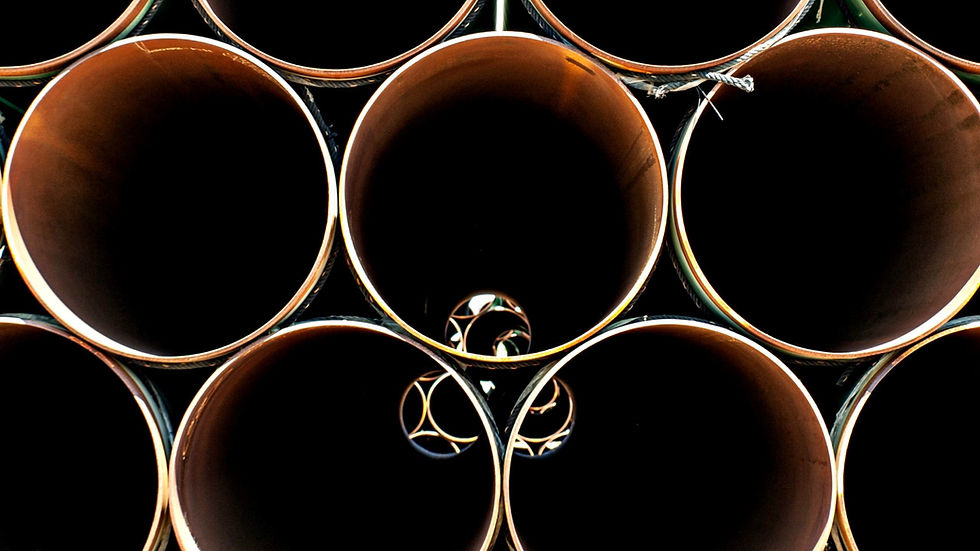Differences Between Hot Rolled and Cold Rolled Seamless Steel Pipes
- Rastahl

- Dec 2, 2024
- 3 min read
What is the difference between hot-rolled seamless steel pipes and cold-rolled seamless steel pipes? Is a regular seamless steel pipe a hot-rolled seamless steel pipe?

Cold-rolled seamless steel pipes are typically small in diameter, while hot-rolled seamless steel pipes are generally larger in diameter. The precision of cold-rolled seamless steel pipes is higher than that of hot-rolled seamless steel pipes, and their price is also higher.
Seamless steel pipes are divided into two types based on their manufacturing processes: hot-rolled (extruded) seamless steel pipes and cold-drawn (rolled) seamless steel pipes. Cold-drawn (rolled) pipes are further classified into round pipes and special-shaped pipes.
1) Different Uses
Hot-rolled seamless pipes are categorized into general steel pipes, low- and medium-pressure boiler steel pipes, high-pressure boiler steel pipes, alloy steel pipes, stainless steel pipes, petroleum cracking pipes, geological steel pipes, and other steel pipes.
Cold-rolled (drawn) seamless steel pipes are divided into general steel pipes, low- and medium-pressure boiler steel pipes, high-pressure boiler steel pipes, alloy steel pipes, stainless steel pipes, petroleum cracking pipes, and others, including thin-walled carbon steel pipes, thin-walled alloy steel pipes, thin-walled stainless steel pipes, and special-shaped steel pipes.
2) Different Sizes
The outer diameter of hot-rolled seamless pipes is typically larger than 32 mm, with a wall thickness ranging from 2.5 to 75 mm. Cold-rolled seamless pipes can have a diameter as small as 6 mm and a wall thickness as thin as 0.25 mm. Thin-walled pipes may have an outer diameter of 5 mm and a wall thickness of less than 0.25 mm. Cold rolling offers higher dimensional precision compared to hot rolling.
3) Process Differences
a) Cold-rolled steel allows local buckling in sections, making full use of the load-bearing capacity of the steel after buckling. Hot-rolled steel, however, does not permit local buckling in sections.
b) Residual stress distribution differs between the two processes. In cold-formed thin-walled steel, the residual stress distribution in the cross-section is curved, whereas in hot-rolled or welded steel, it is more uniform like a thin film.
c) The free torsional stiffness of hot-rolled steel is higher than that of cold-rolled steel, meaning hot-rolled steel has better torsional resistance.
4) Advantages and Disadvantages
Cold-rolled seamless pipes refer to steel sheets or strips processed into various shapes through cold drawing, cold bending, cold rolling, and other processes performed at room temperature. This enhances the pipe's dimensional accuracy, surface finish, and mechanical properties.
Advantages:
Fast forming speed, high productivity, and no damage to coatings; can be shaped into various cross-sectional forms to meet specific application needs.
Cold rolling can induce significant plastic deformation in the steel, enhancing its yield point.
Disadvantages:
Although there is no thermal plastic compression during the forming process, residual stresses remain in the cross-section, which can inevitably affect the general and local buckling characteristics of the steel.
The design of cold-rolled steel typically features an open cross-section, which reduces the free torsional stiffness of the section. As a result, it is prone to torsion when bent and to bending and twisting when compressed, leading to weak torsional resistance.
Cold-rolled steel has a thin wall thickness, and no thickening occurs at the corners where plates are joined, making it less capable of withstanding localized concentrated loads.
Hot-rolled seamless pipes differ from cold-rolled seamless pipes. Cold-rolled seamless pipes are rolled below the recrystallization temperature, whereas hot-rolled seamless pipes are rolled above the recrystallization temperature.

Advantages:
Hot rolling can break down the casting structure of the steel ingot, refine the grain structure, and eliminate microstructural defects, leading to denser steel with improved mechanical properties.
This improvement is primarily reflected along the rolling direction, which means the steel exhibits a certain degree of anisotropy.
Bubbles, cracks, and porosity formed during casting can also be welded together under high temperatures and pressure during the hot rolling process.
Delamination Risk:After hot rolling, non-metallic inclusions in the steel (primarily sulfides, oxides, and silicates) are pressed into thin layers, leading to delamination. Delamination significantly weakens the steel's tensile properties in the thickness direction. During welding shrinkage, interlayer tears can occur. The local strain caused by welding shrinkage often exceeds the yield strain by several times, which is typically much larger than the strain caused by normal loads.
Residual Stress from Uneven Cooling:Residual stress is internally balanced stress within the steel that exists without external forces. Hot-rolled steel profiles with varying cross-sections exhibit such residual stresses. Generally, the larger the cross-section, the greater the residual stress. Although these stresses are self-balancing, they can negatively impact the performance of steel components under external forces, such as deformation, stability, and fatigue resistance.
Control Challenges in Thickness and Width:The thickness and edge width of hot-rolled steel products are difficult to control precisely. This is due to thermal expansion and contraction during the process. While initial dimensions may meet standards, there can be a noticeable negative deviation after final cooling. The larger this deviation, the thicker and more pronounced the impact on the steel's performance.





Comments